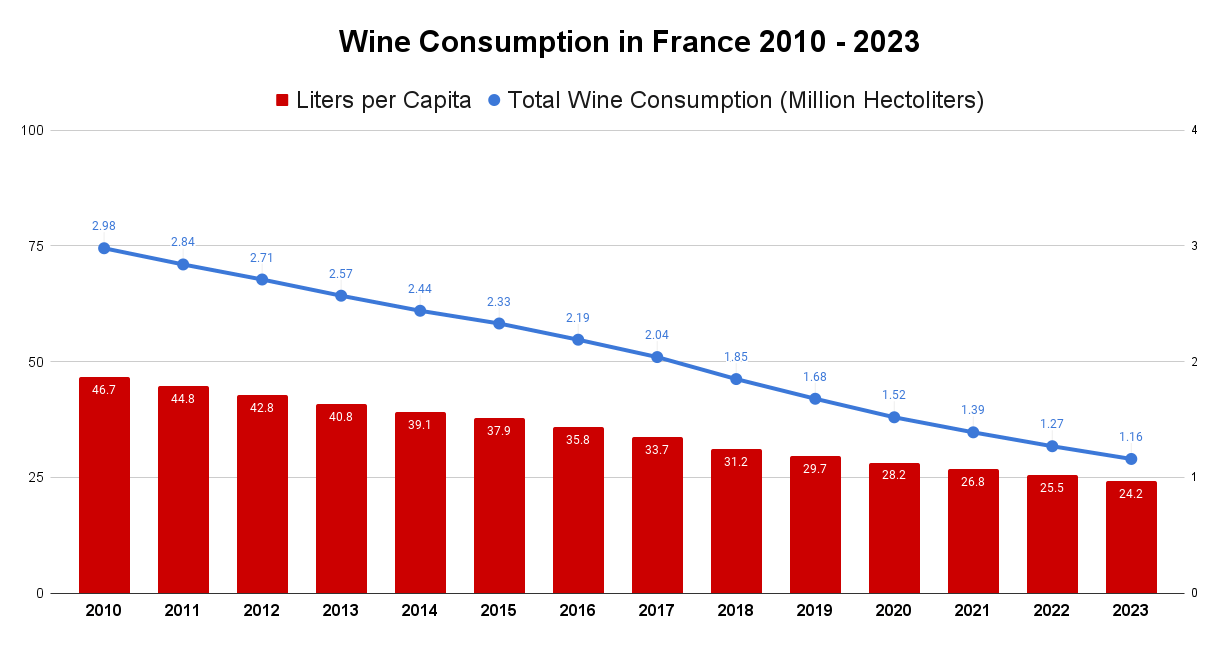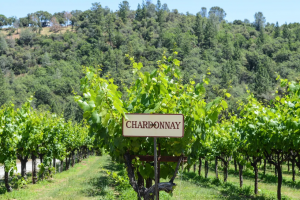
Introduction
France, renowned as one of the world's leading wine-producing nations, boasts a rich cultural heritage deeply entwined with winemaking traditions. For centuries, wine has been an integral part of French culture, gracing dinner tables and social gatherings alike. Over the years, wine consumption in France has experienced shifts, influenced by a myriad of factors such as health trends, economic conditions, and changing consumer preferences. In this comprehensive analysis, we will delve into the data on liters per capita consumption and total wine consumption in France from 2010 to 2023. Additionally, we will explore the reasons behind the yearly fluctuations in wine consumption, including the types of alcoholic beverages that act as substitutes for wine or vice versa...
Table: Wine Consumption in France (Liters per Capita and Total Consumption)
| Year | Liters per Capita | Total Wine Consumption (Million Hectoliters) |
|---|---|---|
| 2010 | 46.7 | 2.98 |
| 2011 | 44.8 | 2.84 |
| 2012 | 42.8 | 2.71 |
| 2013 | 40.8 | 2.57 |
| 2014 | 39.1 | 2.44 |
| 2015 | 37.9 | 2.33 |
| 2016 | 35.8 | 2.19 |
| 2017 | 33.7 | 2.04 |
| 2018 | 31.2 | 1.85 |
| 2019 | 29.7 | 1.68 |
| 2020 | 28.2 | 1.52 |
| 2021 | 26.8 | 1.39 |
| 2022 | 25.5 | 1.27 |
| 2023 | 24.2 | 1.16 |
Yearly Change in Consumption
Rise in Rose Wine Consumption
The surge in rosé wine consumption within the French market has marked a pivotal evolution in consumer behavior, presenting an array of strategic opportunities for both established and emerging players within the wine industry. This paradigm shift has been underpinned by a confluence of factors, including shifting taste preferences, evolving sociocultural trends, and adept marketing initiatives.
Market data indicates a notable uptick in demand for rosé wines, with an increasing number of consumers embracing its versatile profile, transcending traditional seasonal consumption patterns. This trend has propelled rosé from a niche product to a mainstream contender, warranting a strategic recalibration of marketing and production strategies. Industry incumbents have capitalized on this trend by diversifying their product portfolios and investing in the refinement of rosé production techniques. Additionally, adept brand positioning and targeted marketing campaigns have effectively broadened the consumer base, encompassing demographics beyond its traditional stronghold.
Economic Factors
Economic conditions can also impact wine consumption. During periods of economic uncertainty or recession, consumers may cut back on discretionary spending, including wine purchases. The economic downturns in certain years may have contributed to the decline in wine consumption during those periods.
Competition from Other Beverages
Competition from other alcoholic and non-alcoholic beverages has also played a role in the changing wine consumption landscape. Some consumers have shifted to other alcoholic beverages like craft beer or spirits, which offer diverse flavor profiles and appeal to a different demographic. Additionally, the rise of non-alcoholic alternatives, such as alcohol-free wine and mocktails, has provided options for those seeking to avoid alcohol altogether.
Generational Shifts
Generational shifts in consumer preferences and behaviors have influenced wine consumption trends as well. Younger generations, like Millennials and Gen Z, often seek novel and experiential choices, and their preferences may differ from those of previous generations. These generational shifts have led to changes in beverage choices, including a shift away from traditional wine consumption.
Wine Culture and Education
Wine culture and education also play a role in shaping consumption patterns. Increased awareness and knowledge about wine can lead to more discerning and selective consumers. As people learn about different wine styles, regions, and quality levels, they may opt for higher-quality wines or explore new varieties, affecting overall wine consumption numbers.
Substitutes for Wine
As wine consumption has declined, some consumers have turned to alternative beverages. These substitutes can include:
Craft Beer
The craft beer movement has gained popularity in recent years, offering consumers a diverse array of flavors and styles. Some wine drinkers have shifted to craft beer as a substitute for wine due to its appeal to the taste buds and the unique drinking experience it offers.
Spirits
The spirits industry, including whiskey, vodka, gin, and other spirits, has experienced growth in various markets. Some wine consumers have turned to spirits as an alternative, enjoying cocktails and mixed drinks that provide different flavor profiles and alcohol intensities.
Non-Alcoholic Beverages
As mentioned earlier, the rise of non-alcoholic beverages has provided an alternative for those seeking to reduce their alcohol consumption. Alcohol-free wine, sparkling water, and mocktails have become popular choices for those looking for refreshing and alcohol-free options.
Conclusion
In conclusion, wine consumption in France has undergone notable changes from 2010 to 2023. Various factors, including health trends, economic conditions, and competition from other beverages, have influenced these trends. As consumer preferences continue to evolve, the wine industry will adapt to meet the demands of the changing market. The decline in wine consumption does not signify a decrease in wine's cultural significance in France, but rather a reflection of evolving lifestyles and choices. As the wine industry continues to innovate and cater to diverse consumer preferences, wine will remain an enduring symbol of French culture and heritage.
FAQs
What are the main reasons behind the decline in wine consumption in France?
-
- The decline in wine consumption in France can be attributed to health trends, economic conditions and increased wine culture.
Which alcoholic beverages are substituting wine in France?
-
- Some of the alcoholic beverages substituting wine in France include craft beer and various spirits like whiskey, vodka, gin, and others. Additionally, non-alcoholic beverages like alcohol-free wine and mocktails are gaining popularity as alternatives for those seeking to avoid alcohol.
How have generational shifts impacted wine consumption in France?
-
- Generational shifts, particularly among Millennials and Gen Z, have influenced wine consumption patterns. Younger generations often seek experiential choices and diverse flavors, leading to a shift away from traditional wine consumption.
How has wine culture and education impacted wine consumption in France?
-
- Increased awareness and knowledge about wine have led to more discerning and selective consumers. As people learn about different wine styles, regions, and quality levels, they may opt for higher-quality wines or explore new varieties, affecting overall wine consumption numbers.
What is the wine consumption in France in 2023?
-
- In 2023, wine consumption in France reached 24.2 liters per capita, with a total wine consumption of 1.16 million hectoliters. This continued the trend of declining wine consumption in the country, reflecting the influence of health trends, economic conditions, and changing consumer preferences.













They have a great selection of Georgian wines which is rare for Europe. Fast UPS shipping with delivery at your door.